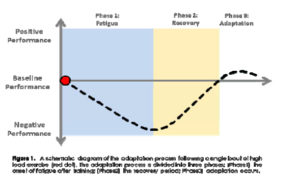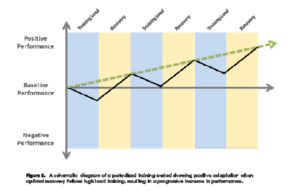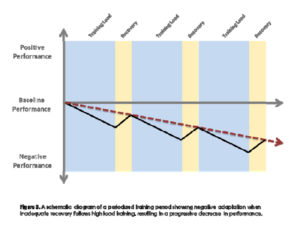The Science of Recovery
Editor’s note: This is the first of a three-part article on recovery. Part one presents an overview of the importance of rest and recovery. Part two summarizes the signs and symptoms of fatigue and the challenges that undermine our attempts to quantify athletes’ recovery status. And part three introduces the first reasonable (inexpensive, valid, simple and intuitive) tool to accurately quantify recovery; RESTWISE.
Part 1: The role of recovery in Performance.
As athletes we all understand the importance of recovery…, or do we? Recovery plays a role in every training program, whether intentional or not. Every athlete who has trained hard and experienced fatigue the following day understands that the body’s resources are finite. Few of us, however, approach recovery with the same intentionality with which we approach training. The result is a failure to effectively utilise recovery, not only to prepare for the next training session, but to increase performance.
One of the more common misconceptions in sport is that since performance gains are derived from hard training, the more one trains the greater the potential for improvement. Wrong! Yes, hard training is necessary to stress the body and initiate the daptation processes which lead to fitness and performance gains. And yes, hard training could be important in psychologically preparing an athlete for the stress of competition. But the fact that most athletes alternate high load training with lighter training sessions, and include more recovery after tough competitions (or hard training blocks), demonstrates the need for recovery. Without sufficient recovery the body is not be able to respond consistently and predictably. As a result, training quality and competition performance will likely be compromised.
Recovery isn’t just important, it’s a biological necessity
– Dr. Vern Neville (Loughborough University)
The human body is a robust structure that continually strives to maintain a state of homeostasis by responding to overcome stress. This is the basis of training adaptation which forms the foundation for all training protocols, and which is divided into three distinct phases (Figure 1). The first phase is the application of training stress, resulting in fatigue and reduced performance. The second phase is the recovery period when the body attempts to overcome and adapt to the stress of training. Phase three is an adaptive rebound above baseline fitness as the body attempts to regain homeostasis. This rebound is often referred to as “supercompensation”.

The aim of this article is to highlight the fact that although training is a necessary stress, to maximize performance requires optimizing the relationship between rest and recovery. It is not how hard one trains that ultimately determines performance, but how smart one trains.
From this, one could conclude that effective training is relatively simple. All one need do is train hard to create the required stress to initiate adaptation and then allow time for the adaptation to occur. True, but… the recovery process becomes complex when one considers that training affects many different energy systems within the body, each requiring a different period of recovery. Furthermore, non-training related stress (daily life; social stress; travel and environmental stress; etc) can substantially influence an athlete’s recovery needs. Recovery requirements may therefore vary considerably between identical training sessions executed at different times. Understanding and implementing optimal recovery is thus a necessary, but challenging part of an effective training plan – optimal recovery will eventually determine the degree to which adaptation (fitness gains) occurs.
In summary, it is not the training load that ultimately determines performance, but rather the precise balance between training load and optimal recovery. Too much recovery and one may be under-training, and too little recovery introduces the very real risk of over-training.
First, let’s look at two scenarios; both are represented by simplified periodization plans (Figure 2 and Figure 3). The blue shaded areas represent periods of intense or high-load training, the yellow areas represent periods of rest and recovery and the horizontal line represents baseline fitness. If the relationship between training and recovery is such that each period of training is followed by an adequate (optimal) period of recovery then the athlete will experience a gradual improvement in performance (Figure 2). A well-structured program – with an optimal training load/recovery ratio – will set the foundations for satisfaction, enjoyment, a positive relationship with the activity and, likely, increased performance.

Conversely, if the training load is increased relative to recovery (or recovery is inadequate), the ratio between training load and recovery becomes unbalanced (Figure 3), leading to a gradual reduction in performance, increased stress, an increased risk of injury and illness and, ultimately, Over Training Syndrome.

The search for performance gains requires the athlete to understand and implement several key processes:
1) First, the athlete needs to have a goal. To increase performance and optimise training requires a clear objective. Working backwards from this goal provides the platform on which to build an optimal training plan.
2) Second, the athlete should understand the science behind any training stimulus and determine what form of stimulus is appropriate for their sport. Sure, one could go out and generically flog oneself, but to maximize the results from each hour spent training requires an understanding of the purpose of the training.
3) Third, the athlete needs a plan; a plan that includes training and recovery. This is called “recovery-aware training” because it brings a sense of purpose to recovery that is as important as the training stimulus. Hard work and crossed fingers isn’t enough.
The challenge of achieving a balanced “recovery-aware training plan” is that most athletes are typically goal-oriented, disciplined and dedicated. As a result they tend to be drawn to (and very good at!) tracking training output – the hours spent training, the kilometres skied, miles run, weights lifted, average heart rate, etc. Fortunately, the relative ease of quantifying output has given rise to a multi-billion dollar industry that supports monitoring training output, such as heart rate monitors; power meters and GPS tracking systems; personal coaches and trainers; and a wide range of on-line training plans. These may be important components of any athlete’s preparation.
However, there is little emphasis invested in other important components of fitness, such as the effects of training or the requirements of recovery. This is largely because recovery has been impossible to quantify, mostly subjective, and can even appear mysterious. The ultimate example of recovery – tapering for a key event – is, to many athletes, a black art.
Despite the wealth of available research on the subject, the specific amount and schedule of recovery required to peak, remains opaque to most athletes (if not also to most coaches).
How often have you asked yourself: “I’m putting in all this training time… why am I not getting faster”? And have you ever felt like you needed a day off, but ended up training because you ‘needed’ to keep up with your peers? And how many of us have added a few additional hard workouts in the weeks leading up to a key race for no reason beyond a
sense of insecurity that we haven’t done enough to prepare? The combination of not having a recovery-aware training plan, ignorance of the science that supports training methodology, competitive pressure and the perception that “more is better” often results in athletes failing to give recovery the same importance that they give to training. The result is, all too frequently, failure to achieve an athlete’s best performance.


No Comments